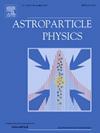SMIET:使用模拟模板快速准确地合成来自广泛空气淋室的无线电脉冲
IF 2.9
3区 物理与天体物理
Q1 ASTRONOMY & ASTROPHYSICS
引用次数: 0
摘要
解释来自无线电探测器的大范围空气阵雨的数据通常依赖于基于蒙特卡罗的模拟代码,尽管它们的准确性很高,但计算成本很高,并且存在分析瓶颈。为了解决这个问题,我们开发了一种新的正演模型,称为模板合成,它在几秒钟内合成宇宙射线空气阵雨的射电发射。这种混合方法使用显微镜模拟的切片淋浴(原点)作为输入。它重新调整每个片的发射,以合成具有不同属性(目标)的阵雨的发射。在这个过程中,它采用半解析关系,依赖于片内的淋浴年龄。我们使用视角描述天线和片之间的连接,并使用一组缩放关系将每个片的发射相对于风淋几何形状归一化。为了能够在合成过程中改变到达方向,我们根据期望的几何延迟来调整相位。我们通过在[30,500]MHz的宽频率范围内将合成走线与CoREAS模拟进行比较,对该方法进行基准测试。我们比较了信号的幅度和影响。合成质量主要受源雨和目标雨的Xmax差异ΔXmax的影响。当ΔXmax≤100g/cm2时,地磁道最大幅值上的散射最多为4%。对于来自电荷过量分量的迹线,这种散射小于6%。我们还观察到两个组件的偏差ΔXmax高达5%,这似乎取决于天线位置。由于偏置在ΔXmax=0g/cm2周围是对称的,我们可以使用插值方法来纠正它。虽然它提高了合成的准确性,但它需要多个原点阵雨,增加了方法的复杂性。我们在名为SMIET的开源Python包中实现了模板合成算法,该包包含应用该方法所需的所有参数。使用者只需要提供足够的淋浴设施。该包提供了NumPy中算法的实现,但也提供了JAX框架中的替代实现,使代码完全可微分。该套件已成功地与天顶角高达50°的空气淋浴器进行了测试,可用于任何大气,观测水平和磁场。我们证明,在各种场景中,合成质量仍然与我们的主要基准相当,并讨论了潜在的用例,包括它在基于机器学习的重建中的使用。质量很大程度上取决于源和目标阵雨之间天顶角的差异,由此我们得出结论,进一步改进相位处理是必要的。本文章由计算机程序翻译,如有差异,请以英文原文为准。
SMIET: Fast and accurate synthesis of radio pulses from extensive air shower using simulated templates
Interpreting the data from radio detectors for extensive air showers typically relies on Monte-Carlo based simulation codes, which, despite their accuracy are computationally expensive and present bottlenecks for analyses. To address this issue we have developed a novel forward model called template synthesis, which synthesises the radio emission from cosmic ray air showers in a matter of seconds. This hybrid approach uses a microscopically simulated, sliced shower (the origin) as an input. It rescales the emission from each slice individually to synthesise the emission from a shower with different properties (the target). In this process it employs semi-analytical relations dependent on the shower age within the slice. We describe the connection between an antenna and a slice using the viewing angle and normalise the emission from every slice with respect to the air shower geometry using a set of scaling relations. In order to be able to change the arrival direction during synthesis, we adjust the phases based on the expected geometrical delays.
We benchmark the method by comparing synthesised traces to CoREAS simulations over a wide frequency range of [30, 500] . We compare the signal amplitudes as well as the fluences. The synthesis quality is primarily influenced by the difference in between the origin and target shower, . When , the scatter on the maximum amplitudes of the geomagnetic traces is at most 4%. For the traces from the charge-excess component this scatter is smaller than 6%. We also observe a bias with up to 5% for both components, which appears to depend on the antenna position. Since the bias is symmetrical around , we can use an interpolation approach to correct for it. While it improves the accuracy of the synthesis, it requires multiple origin showers, increasing the complexity of the approach.
We have implemented the template synthesis algorithm in an open-source Python package called SMIET, which includes all the necessary parameters to apply the method. Users only need to provide adequate origin showers. The package provides an implementation of the algorithm in NumPy, but also offers an alternative implementation in the JAX framework which makes the code fully differentiable. This package has been successfully tested with air showers with zenith angles up to 50° and can be used with any atmosphere, observation level and magnetic field. We demonstrate that the synthesis quality remains comparable to our main benchmarks across various scenarios and discuss potential use cases, including its use in machine-learning-based reconstructions. The quality does depend strongly on the difference in zenith angle between the origin and target shower, from which we conclude that further improvements to the phase treatment are necessary.
求助全文
通过发布文献求助,成功后即可免费获取论文全文。
去求助
来源期刊

Astroparticle Physics
地学天文-天文与天体物理
CiteScore
8.00
自引率
2.90%
发文量
41
审稿时长
79 days
期刊介绍:
Astroparticle Physics publishes experimental and theoretical research papers in the interacting fields of Cosmic Ray Physics, Astronomy and Astrophysics, Cosmology and Particle Physics focusing on new developments in the following areas: High-energy cosmic-ray physics and astrophysics; Particle cosmology; Particle astrophysics; Related astrophysics: supernova, AGN, cosmic abundances, dark matter etc.; Gravitational waves; High-energy, VHE and UHE gamma-ray astronomy; High- and low-energy neutrino astronomy; Instrumentation and detector developments related to the above-mentioned fields.
 求助内容:
求助内容: 应助结果提醒方式:
应助结果提醒方式:


